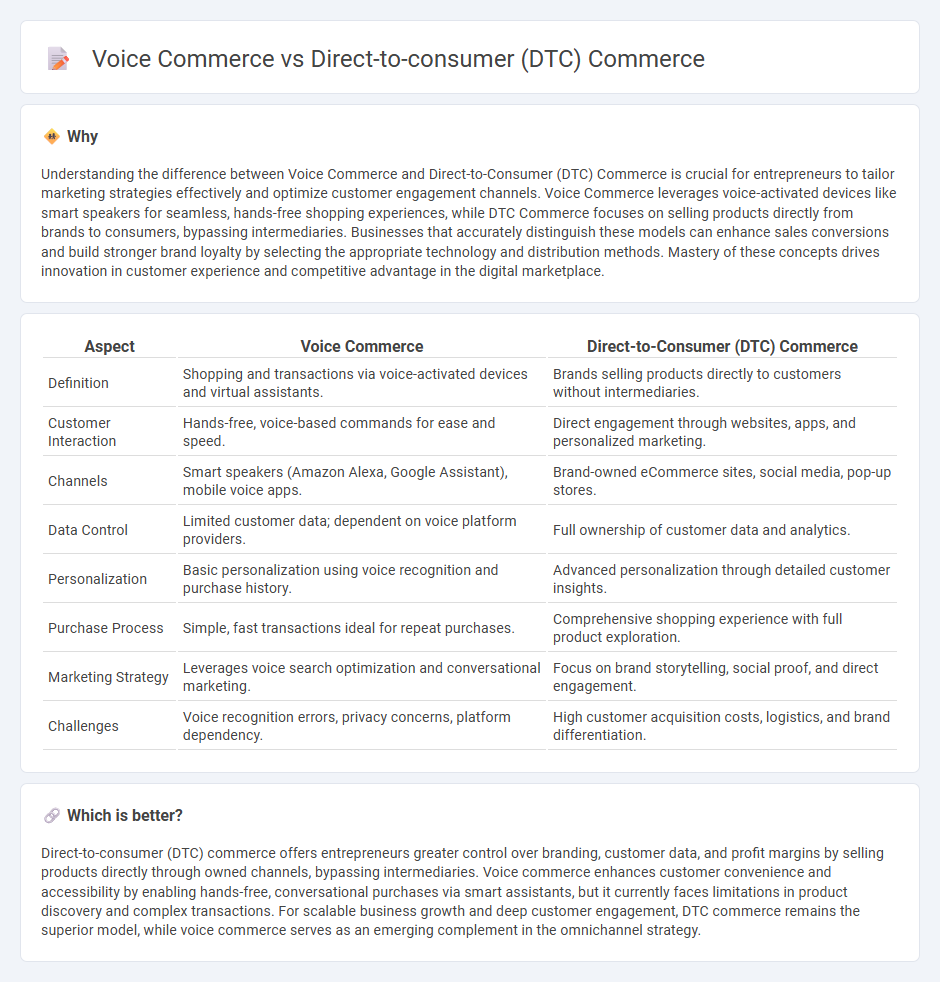
Voice commerce leverages voice-activated technology for seamless shopping experiences, tapping into the rapid growth of smart speaker usage, which is projected to reach 55% of U.S. households by 2025. Direct-to-consumer (DTC) commerce removes intermediaries by selling products directly through brand-owned channels, boosting customer loyalty and collecting valuable first-party data. Explore how these cutting-edge models transform entrepreneurial strategies and consumer engagement.
Why it is important
Understanding the difference between Voice Commerce and Direct-to-Consumer (DTC) Commerce is crucial for entrepreneurs to tailor marketing strategies effectively and optimize customer engagement channels. Voice Commerce leverages voice-activated devices like smart speakers for seamless, hands-free shopping experiences, while DTC Commerce focuses on selling products directly from brands to consumers, bypassing intermediaries. Businesses that accurately distinguish these models can enhance sales conversions and build stronger brand loyalty by selecting the appropriate technology and distribution methods. Mastery of these concepts drives innovation in customer experience and competitive advantage in the digital marketplace.
Comparison Table
| Aspect | Voice Commerce | Direct-to-Consumer (DTC) Commerce |
|---|---|---|
| Definition | Shopping and transactions via voice-activated devices and virtual assistants. | Brands selling products directly to customers without intermediaries. |
| Customer Interaction | Hands-free, voice-based commands for ease and speed. | Direct engagement through websites, apps, and personalized marketing. |
| Channels | Smart speakers (Amazon Alexa, Google Assistant), mobile voice apps. | Brand-owned eCommerce sites, social media, pop-up stores. |
| Data Control | Limited customer data; dependent on voice platform providers. | Full ownership of customer data and analytics. |
| Personalization | Basic personalization using voice recognition and purchase history. | Advanced personalization through detailed customer insights. |
| Purchase Process | Simple, fast transactions ideal for repeat purchases. | Comprehensive shopping experience with full product exploration. |
| Marketing Strategy | Leverages voice search optimization and conversational marketing. | Focus on brand storytelling, social proof, and direct engagement. |
| Challenges | Voice recognition errors, privacy concerns, platform dependency. | High customer acquisition costs, logistics, and brand differentiation. |
Which is better?
Direct-to-consumer (DTC) commerce offers entrepreneurs greater control over branding, customer data, and profit margins by selling products directly through owned channels, bypassing intermediaries. Voice commerce enhances customer convenience and accessibility by enabling hands-free, conversational purchases via smart assistants, but it currently faces limitations in product discovery and complex transactions. For scalable business growth and deep customer engagement, DTC commerce remains the superior model, while voice commerce serves as an emerging complement in the omnichannel strategy.
Connection
Voice commerce revolutionizes Direct-to-Consumer (DTC) commerce by enabling seamless, hands-free purchasing experiences that increase consumer engagement and drive higher conversion rates. Integrating voice-activated devices with DTC platforms allows entrepreneurs to gather valuable customer data, personalize marketing strategies, and streamline the sales funnel. The synergy between voice commerce technology and DTC models fosters innovative growth opportunities, enhancing brand loyalty and expanding market reach.
Key Terms
Customer Acquisition
Direct-to-consumer (DTC) commerce leverages personalized marketing and data-driven strategies to enhance customer acquisition by directly targeting and engaging consumers through digital channels. Voice commerce utilizes voice-activated devices and natural language processing to streamline purchasing, making it easier for users to discover and buy products hands-free, potentially expanding customer reach. Explore how these innovative approaches reshape customer acquisition by diving deeper into their unique advantages and challenges.
Personalization
Direct-to-consumer (DTC) commerce leverages detailed customer data to deliver personalized marketing, customized product recommendations, and tailored shopping experiences that enhance customer loyalty and lifetime value. Voice commerce utilizes natural language processing and AI-driven voice assistants to provide hands-free, convenient shopping, with personalization based on voice recognition, past purchases, and contextual data for real-time interaction. Explore how these cutting-edge personalization strategies redefine customer engagement and drive sales in modern retail ecosystems.
Conversational Interface
Direct-to-consumer (DTC) commerce empowers brands to sell products directly to customers, enhancing personalized shopping experiences through websites and apps, while voice commerce utilizes conversational interfaces like smart speakers for hands-free, natural language transactions. Voice commerce leverages AI-powered voice assistants such as Amazon Alexa and Google Assistant, enabling seamless product discovery and streamlined checkouts via spoken commands. Explore how conversational interfaces revolutionize the consumer journey and boost sales efficiency in evolving e-commerce landscapes.
Source and External Links
Direct to Consumer (DTC) Sales: Tips and Examples - Direct-to-consumer (DTC) commerce is a business model where brands or manufacturers sell products directly to customers without intermediaries, offering more brand control, better customer insights, and higher profit margins.
What Is DTC in Ecommerce, and How Does It Work? - DTC ecommerce bypasses wholesalers, distributors, and retailers, selling products straight from the manufacturer's website to consumers, enabling manufacturers to capture higher margins and maintain direct customer relationships.
Direct-to-consumer - The DTC model refers to selling products directly to customers, typically online, bypassing third-party retailers and wholesalers, with notable brands like Allbirds and Warby Parker using this method to strengthen consumer connections.
 dowidth.com
dowidth.com